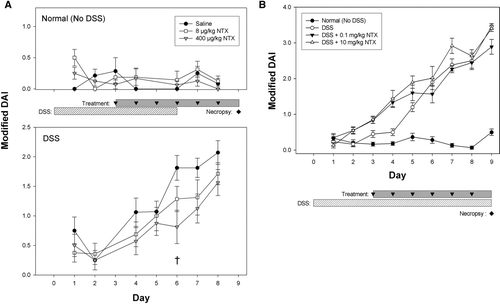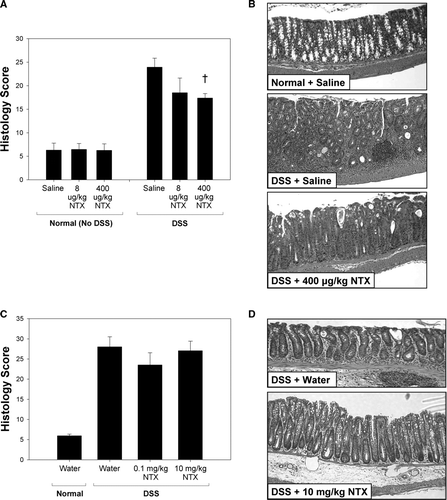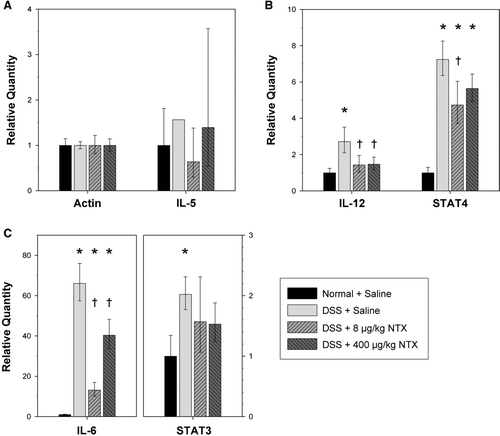Figures & data
FIG. 1 Daily weight, food and water consumption. (A) Mean weight (expressed as % starting weight ± SEM) of animals receiving either normal drinking water (upper panel) or 2% DSS in drinking water (lower panel) is shown. DSS-induced weight loss was lessened by treatment with naltrexone (NTX) in moderate colitis by Day 6. (B) Mean daily food intake in grams per mouse and (C) total water intake in ml per mouse over the 9-day course of study is shown. Asterisks indicate significantly different values between corresponding DSS and Normal (No DSS) treatment groups (*p < 0.025; **p < 0.005). Significant differences in water intake between saline- and 8 μ g/kg NTX-treated mice are indicated by a †(p = 0.022).

FIG. 2 Naltrexone treatment reduces Disease Activity Index (DAI) scores. Mice that received normal drinking water (saline or NTX-treated) showed no evidence of colitis by DAI score (A, upper panel; mean ± SEM). DAI scores increased over time in both the moderate (A, lower panel) and the severe colitis (B) studies. Treatment with 400 μ g/kg NTX significantly lowered DAI scores in moderate colitis on Day 6 († p = 0.015). In contrast, NTX failed to improve DAI scores of the severe colitis model (B).

FIG. 3 Histologic scores are improved in moderate colitis mice treated with naltrexone. At necropsy, longitudinal sections of the distal colon were H&E stained and evaluated using the scoring system of Williams and colleagues (2001). Histology scores are expressed as the mean ± SEM. Normal histology was observed in animals drinking untreated water compared to high inflammatory scores in DSS-treated animals (A). Naltrexone treatment improved the histologic scores in animals with moderate colitis (A). Representative H&E sections of distal colon from animals with moderate colitis are shown in B. Compared to the normal appearance of healthy murine colon (Normal + saline; top), leukocyte infiltration and an absence of normal crypt architecture are evident in the DSS + saline mice (middle). Improved architecture and less inflammation are clearly discernable in DSS mice treated with 400 μ g/kg NTX (bottom). Cross indicates significantly different values between DSS + saline and DSS + 400 μ g/kg NTX (p = 0.018). In contrast, NTX was unable to reverse the inflammatory response observed in the severe colitis model (C, D).

FIG. 4 Gene expression of DSS-induced pro-inflammatory cytokines is decreased by naltrexone. Relative mRNA levels for (A) beta-actin and the cytokine IL-5; (B) cytokine IL-12 and downstream mediator STAT4; and (C) cytokine IL-6 and downstream mediator STAT3, were determined by Real-time RT-PCR using total RNA from the distal colon. Target genes were calibrated to 18S rRNA, and means were normalized to beta-actin expression for each corresponding treatment group. Histogram columns represent the mean relative quantity (RQ = 2- Δ Δ CT) and bars represent a 95% confidence interval (CI; RQ = 2- (Δ Δ CT± CI)). DSS induced significant elevations in the RNA of pro-inflammatory cytokines IL-6 and IL-12. However, mice treated with naltrexone exhibited restoration toward normal levels. Asterisks indicate significantly different values between corresponding Normal + saline and each DSS treatment group (*p < 0.0008). Significant differences between DSS-Saline and DSS-NTX mice are indicated by a † (IL-12, p < 0.005; STAT4, p < 0.024; IL-6, p < 0.0008).

